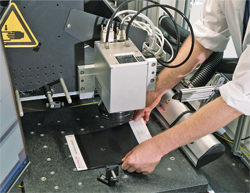10 December 2018
SCANLAB provides even greater precision while scanning without limits
 Laser processing is often constrained by a scanner’s image field. Large-scale processing traditionally gets performed stepwise via individual image fields, called ‘tiles’. But this method bears the risk of longer process times and stitching errors, i.e. misaligned marking at image field boundaries. To overcome this problem, SCANLAB and ACS Motion Control last year introduced a new scan concept. XL SCAN and the jointly developed syncAXIS control software enable simultaneous control of an excelliSCAN scan head and a mechanical XY stage with two servo axes. This solution employs an RTC6 control board to transmit motion profiles to both stage and scanner. The application’s precision is thereby limited solely by the stage’s and scanner’s precision – the control itself introduces no additional error. This concept decisively differentiates XL SCAN from competitors’ systems that close a feedback loop between the scan system and stage, but are constrained by very slow dynamics. A typical feedback loop’s 10-µs transmission/preview latency, together with a scanner speed of 2.5 m/s, could already cause deviations of 25 µm.
Laser processing is often constrained by a scanner’s image field. Large-scale processing traditionally gets performed stepwise via individual image fields, called ‘tiles’. But this method bears the risk of longer process times and stitching errors, i.e. misaligned marking at image field boundaries. To overcome this problem, SCANLAB and ACS Motion Control last year introduced a new scan concept. XL SCAN and the jointly developed syncAXIS control software enable simultaneous control of an excelliSCAN scan head and a mechanical XY stage with two servo axes. This solution employs an RTC6 control board to transmit motion profiles to both stage and scanner. The application’s precision is thereby limited solely by the stage’s and scanner’s precision – the control itself introduces no additional error. This concept decisively differentiates XL SCAN from competitors’ systems that close a feedback loop between the scan system and stage, but are constrained by very slow dynamics. A typical feedback loop’s 10-µs transmission/preview latency, together with a scanner speed of 2.5 m/s, could already cause deviations of 25 µm.
Positive Effects of Control
Larger systems can even employ multiple instances – such as two scan heads and four stages – controlled from a single PC. The new scan concept has meanwhile proven itself in diverse industrial and research organization applications, and its functionality is being further extended based on customer feedback.
A new trajectory planner enables exact control of two laser parameters in conjunction with triggerable USP lasers. For users, this means a controllable pulse interval on the middle line or the inner contour of the laser track. Also available is laser power control – completely independently of scan patterns or motion speeds. Plus, syncAXIS control allows also with various deflection angles to assure a constant fluence on the workpiece.
“We’re positively surprised by our customers’ feedback. For instance, customers’ tests of XL SCAN for display fabrication and glass surface processing boosted their precision by a factor of 3 compared to other manufacturers’ systems,” reports SCANLAB CEO Georg Hofner regarding experience gained in recent months. “Appreciably enhanced user productivity is probably a further factor behind growing demand for this combined scan solution.”
- Contact Information
- Name: Erica Hornbogner
- Email: info@scanlab.de
- Website: www.scanlab.de

